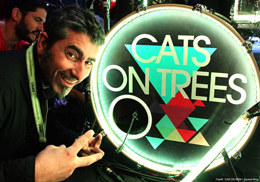
Live mix engineer Verlaine Levis formerly thought that DPA microphones, but since using a selection of them on the current Cats On Trees tour, he notes that his initial perception was off-base.
“When DPA’s French distributor, Audio², gave me the opportunity to try the company’s microphones with Cats On Trees, I was happy to accept the challenge,” Levis explains. “It didn’t take long to discover that these great microphones have beefy pickups and are perfectly suited to rock and pop acts.”
Specifically, he’s using three d:facto vocal microphones, as well as a d:dicate ST2011C stereo pair with 2011C compact cardioids, and a number of d:vote 4099 instrument microphones for drums and violins.
Levis, who began his career with French sound company Audio-Lum, started working as a engineer in 2001 and has toured with the likes of Sidilarsen, Claude Sicre, Bombs 2 Bal, Zebda, Magyd Cherfi and Mouss and Hakim. He’s also building a reputation as a recording engineer, having been asked by a number of artists to assist with studio sessions.
Cats On Trees, a French duo consisting of Nina Goern and Yohan Hennequin, specializes in ambient indie pop and has released one self-titled album along with several singles, including “Sirens Call,” which reached number 3 on the French charts in 2013. The band is now halfway through a European tour that will see them play nearly 200 dates in various countries, including France, Germany, England and Spain.
“The tour is awesome and they are playing to virtually full houses every time,” Levis says. “Since September, they have been performing with a string quartet, but because we have such a busy touring schedule, there hasn’t been much time for residency work or to prepare the mix. Therefore, the show is being built as we go along.”
Levis runs front of house sound, the mix for the in-ear monitors, and the shipment of sequences since he mixes upstream. “With the help of our lighting person, we have set up a network between sound, light and stage,” he explains. “He controls the lights and video via a MIDI controller, but I am the master of the Mac, which manages the sequences and the network. Feeling comfortable is of ultimate importance to the artist, so I try hard to achieve that. With this duo, it is very difficult to create a show that is the same every time because they are constantly changing things.”
The progressive evolution of the show was a key reason Levis decided to switch to DPA microphones. He had previously used DPA’s omnidirectional microphones to record voice ensembles and orchestras in churches, so he knew that the mics could faithfully recreate the acoustics of a venue. After speaking to Audio², he tried out various mic combinations until he found ones that worked for him.
“I had a very clear idea of how each instrument should sound,” he notes. “I wanted to bring several omnidirectional microphones on tour so that I could capture the natural color of the instruments, but because of the on-stage proximity of the drums and piano, this was not possible. As it stands, only the ambient microphones are omnidirectional.”
Levis eventually opted for d:vote 4099 instrument mics for the drum kit and was immediately impressed by the sound, which he feels is very powerful and very natural. “These microphones really pick up extreme levels—they are great,” he says. “We now have d:vote 4099s on the bass drum, snare, toms and violin. I even had them under the cymbals this summer.
“I’m most impressed with the way they capture the sound of the bass drum,” he continues. “I position the mic at the entrance of the drum and slightly inside it. Although the capsule is very small, it still delivers the most amazingly deep, accurate bass.”
Levis is also using d:facto vocal mics, which have solved the feedback issues he was having with other mics. The band has three on stage – one for Yohan on drums and two for Nina as she sings in two different locations.
“For Yohan, the issue was his drum kit,” Levis says. “I was afraid his vocal mic would pick up a lot of extraneous sounds, but what I achieved with d:facto was a clarity to his voice that no other mic would have given me. I just had to think carefully about the positioning of his microphone to avoid rear rejection. Furthermore, the d:facto has a very high gain and its gain before feedback is incomparable.”
“As for Nina, well, to be honest, it was she who chose d:facto – not me,” he continues. “We’d tried a number of different mics, but it was d:facto that she really liked. I never impose a microphone on a singer and I even made her do a blind test because I wanted to be sure she was 100 percent comfortable with the way her voice sounded. She immediately noticed the difference and now doesn’t want to sing with any other microphone.”
The fact that DPA microphones deliver a very precise sound has given Levis’ mixes more accuracy and finesse. The mics have also made everyone more demanding when it comes to sound quality, especially when it comes to tuning drum kits.
“For me, the DPA microphones can be summarized in two words: natural and punchy,” he concludes. “What’s more, they are very rugged. I’ve broken three microphones so far on this tour, but not a single one of them has been a DPA.”
